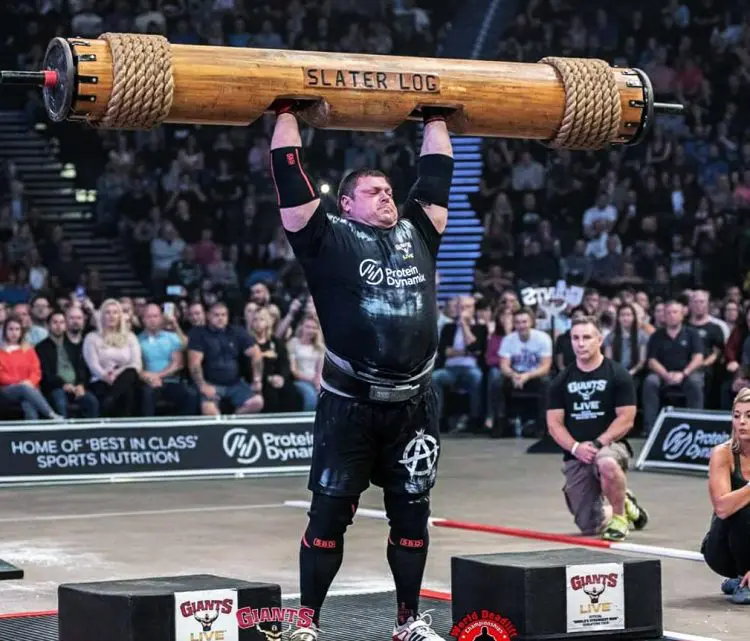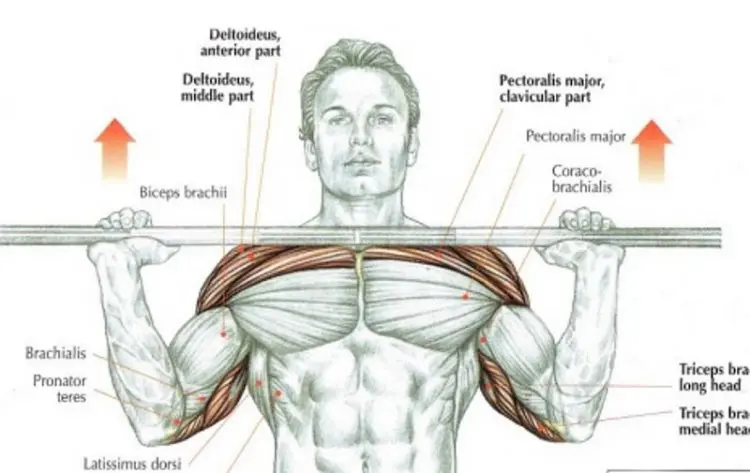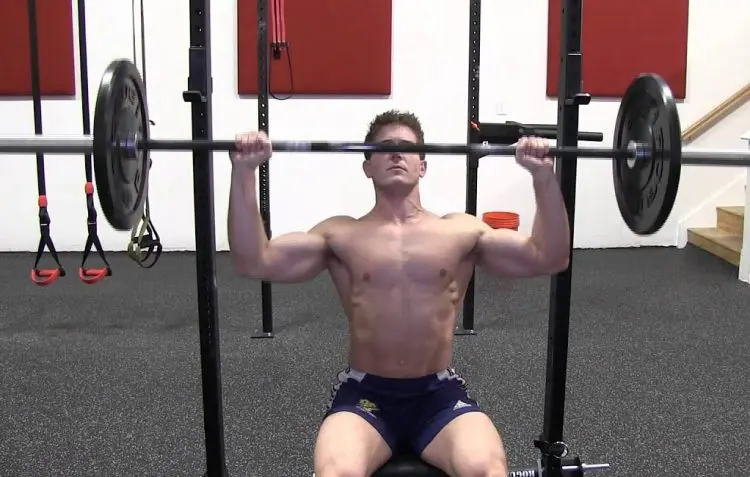The bench press is a relatively recent addition to the exercise hall of fame. Invented shortly after the second world war, before this, most pressing exercises were done standing and overhead. If you wanted to work your chest, you did dips, push-ups, or floor presses.
However, soon after its inception, the bench press quickly became one of the most popular strength training exercises. Even people who don’t lift will probably want to know how much you can bench!
Bench presses have since been a cornerstone exercise for bodybuilders, are used as part of the NFL combine, and are the second lift contested in powerlifting. It’s safe to say that the bench press is here to stay.
While there is nothing inherently wrong with the bench press, its rise in popularity meant that overhead presses started to fall out of favor. In fact, the press was dropped from Olympic lifting because of safety concerns.
Overhead pressing might not be as popular as the bench press, but it still deserves to be part of your workout. In this article, we explain how to do an exercise called the Z Press, arguably the champ of overhead pressing movements.
What Is the Z Press?
The Z press is a barbell overhead pressing exercise named after legendary Lithuanian strongman Žydrūnas Savickas, better known as Big Z. While Big Z was and still is a tremendous all-around strongman, he is especially known for his prodigious strength in the overhead lifts, having held several records in the log press, axel press, and metal block press.
Level Up Your Fitness: Join our 💪 strong community in Fitness Volt Newsletter. Get daily inspiration, expert-backed workouts, nutrition tips, the latest in strength sports, and the support you need to reach your goals. Subscribe for free!
In simple terms, the Z press involves pressing a barbell overhead while sat on the floor with your legs extended in front of you. This eliminates your legs from the movement, so you have to rely entirely on your upper body to complete each rep. Z presses also force you to use your core to keep your torso upright.
The Z press was Big Z’s secret weapon and helped him become one of the best overhead pressers of all time. It worked for him, and it could work for you too!
Z Press Muscles Worked
The Z press is a compound upper body pushing exercise, so it involves several muscles and joints working together. The main muscles involved in the Z press are:
Deltoids – the deltoids are your main shoulder muscles. There are three distinct sections or heads to the deltoids: anterior (front), medial (side), and posterior (rear). All three heads are involved in the Z press, but anterior and medial are the most active.
Trapezius – known as the traps for short, this diamond-shaped muscle is located across your upper back. There are three sets of fibers in the traps, giving it three functions. The upper traps elevate your shoulder girdle, the middle traps retract your shoulder girdle, while the lower traps depress the shoulder girdle. All three fibers work during the Z press, but the upper and middle fibers do more work than the lower fibers.
Triceps brachii – meaning three-headed arm muscle, the triceps are located on the back of your upper arm. Its main function is the extension of your elbow, but it’s also involved in shoulder extension. While Z presses are best thought of as a deltoid exercise, they’re also very useful for building bigger, stronger triceps.
Core – the collective term for the muscles of your midsection, your core acts as a muscular weightlifting belt to support your spine during Z presses. With no bench to lean on, your core will have to work overtime to support your upper body and the weight you are pressing. When you contract or brace your core, it squeezes inward to compress your abdominal contents and increase intra-abdominal pressure. This helps support your spine from within. Z presses are a very core-centric exercise.
How to Do the Z Press
The Z press is by no means an easy exercise to master. It requires excellent lower body flexibility, good upper body mobility, and a strong core. Make sure you have mastered regular overhead presses before attempting this move.
As always, there are two ways to do most exercises; the right way and the wrong way. The right way produces the best results with the least amount of risk, while the wrong way could cause serious injury.
Follow these steps to make sure you do Z presses the right way!
- Between the uprights of a squat rack, sit on the floor with your legs straight and spread wide for balance. Place a barbell on the J-hooks at about shoulder height. Sit up tall, brace your abs, and hold the bar with an overhand, slightly wider than shoulder-width grip.
- With your core tight and shoulders down and back, unrack the bar and hold it across your shoulders as you would for regular overhead presses. Do not lean forward or back. Lift your chest.
- Keeping your core tight, press the bar up and overhead.
- Lower the bar back to your shoulders and repeat.
- Focus on maintaining a good upright posture and tight core throughout. Do not allow your lower back to round, so no slouching!
Z Press Benefits
We’ll be the first to admit that the Z press is a tricky exercise. With no back support, you’re going to have to work really hard to keep your torso upright, and if you’ve been skipping your flexibility training, you may find that you are unable to even get into the correct starting position.
So, does that mean the Z press is more trouble than it’s worth? No way! Here are the main benefits of the Z press.
Increased upper body strength and size – by taking your legs out of the lift, the Z press is a very pure upper body pressing exercise. You cannot cheat the weight up. This makes it more challenging than almost every other overhead pressing exercise, and that means it’s more effective too. If you want massive delts and triceps, and a wicked V-taper, this is the exercise for you.
Improved thoracic mobility and shoulder health – with no bench to hold you in position, you’re going to have to work hard to keep your torso upright and press the weight through the optimal movement path. This requires and develops good thoracic (upper spine) mobility and healthier shoulders. Everyone who lifts will be glad to have less shoulder pain, and better thoracic mobility will improve your posture and your front squat rack position.
More core strength – for most lifters, core training means a few sets of crunches and leg raises at the end of a workout. However, real core strength comes from supporting heavy weights. You cannot avoid using your core during Z presses, so if you want an iron-clad midsection, make sure you include the Z press in your workouts.
Level Up Your Fitness: Join our 💪 strong community in Fitness Volt Newsletter. Get daily inspiration, expert-backed workouts, nutrition tips, the latest in strength sports, and the support you need to reach your goals. Subscribe for free!
Better hamstring flexibility – sitting with your legs extended in front of you and your torso upright is a test of hamstring flexibility that many people will fail! Long periods seated at a desk combined with not enough stretching means that a lot of people have tight hamstrings.
Tight hammies mean your lower back is more likely to round during squats, deadlifts, and bent over rows. Doing Z presses will make any hamstring flexibility issues impossible to ignore and should motivate you to do more stretching.
Better pressing power – as we used to say in the marines, train hard and fight easy. The Z press is so much more challenging than every other pressing exercise that it will make all other overhead presses feel easy in comparison. Do a few training cycles of Z presses, and your old overhead pressing records will soon be left in the dust.
Z Press Variations and Alternatives
As the old saying goes, there is more than one way to skin a cat. Weird expressions aside, it’s always helpful to know variations and alternatives to the exercises in your workouts so you can keep things fresh and interesting. Also, given how awkward the Z press is, you may appreciate some regressions to make this exercise more manageable.
1. Elevated Z Press
If you can’t sit on the floor with your legs straight and your torso upright, you probably have tight hamstrings. Stretching will help, but it takes time to increase your flexibility. In the meantime, try doing the Z press sitting on an 8 to 12-inch step to take tension off your hammies. Lower the step as your hamstrings become more flexible.
You can use this variation with all of the following Z press exercises.
2. Z Press with Legs Together
Most people do Z presses with a wide, straddled stance for stability. Wide legs also take the tension out of the hamstrings, often allowing for a more upright posture. If you’ve got good flexibility, try doing Z presses with your legs together. Not only does this increase the flexibility demand of this exercise, but it also reduces balance and stability, so you’ll have to use your core more.
3. Dumbbell Z Press
A lot of lifters find dumbbells easier and more comfortable to handle than a barbell for Z presses. With a barbell, the weight is slightly in front of your center of gravity, and you have to maneuver it around your head as you lift and lower it. With dumbbells, the weights are better aligned with your torso, and their pathway is more forgiving.
On the downside, you will have to coordinate two weights instead of one, but you should find that your balance soon improves.
How to do it:
- Sit on the floor with your legs straight and your torso upright.
- Hold a dumbbell in each hand at shoulder height. Use a neutral or palms facing forward grip as preferred. Brace your abs and pull your shoulders down and back. Lift your chest.
- Without leaning back, press the weights up and overhead.
- Lower them back to your shoulders and repeat.
- Use kettlebells instead of dumbbells if preferred.
4. Unilateral Z-Press
The Z press is already an effective core exercise but done unilaterally (one-handed), your core will have to work even harder to keep your torso upright. Perform this exercise the same as #2, but just use one dumbbell or kettlebell. Brace your core to ensure your torso remains vertical – no leaning to the side! Do the same number of reps with both arms.
5. Z Press From Pins
Doing the Z press from the pins in a power rack means that each rep starts from a dead stop. This gives you a chance to reset your core between efforts and makes the exercise more challenging because you’ll have to put more effort into overcoming inertia and getting the weight moving.
To do this exercise, set the safety bars in your power rack so that they are at the bottom of your range of motion for Z presses. Sit below the bar and start each rep with the weight resting on the pins.
6. Landmine Z Press
With landmine Z presses, you push the weight not just upward but slightly forward too. This changes the movement pattern, which is useful for the sake of variety, and also increases anterior core activation. This is also a very shoulder-friendly Z press variation.
How to do it:
- Sit on the floor with your legs straight and your torso upright.
- Hold the end of the landmine bar at shoulder height, using a neutral or palms-in grip.
- Press the weight up and forward to arms’ length.
- Lower it back to your shoulder and repeat.
- Do the same number of reps on both sides.
7. Smith Machine Z Press
The Smith machine is a divisive workout tool, with some people loving it while others hate it. In truth, it’s not a good or bad machine, and it has its uses. The Smith machine Z press makes balancing the weight considerably easier and reduces some of the stress on your core, leaving you free to focus on pressing the weight up. If you want to overload your shoulders with Z presses, this is the variation to use.
How to do it:
- Set the bar on your Smith machine to about waist height. Sit on the floor below the bar with your legs straight and apart for balance. Hold the bar with an overhand, slightly wider than shoulder-width grip. Brace your abs.
- Keeping your torso upright and your chest up, press the bar up and overhead. You’ll need to lean back slightly to avoid hitting your chin.
- Lower the bar back to shoulder height and repeat.
8. Pike Push-up
No weights? No problem! You can do an exercise that’s very similar to Z presses using just your body weight. Pike push-ups put your body into a z press-like position but, instead of lifting an external load, you’ll press your body weight up instead. This is a good option for those times you want to get your Z press fix but can’t make it to the gym.
How to do it:
- With a bench or step behind you, squat down and place your hands on the floor about shoulder-width apart, fingers pointing forward. Put your feet on the bench and lift your butt so your hips are flexed to 90-degrees. Brace your core.
- Bend your arms and lower your head down to the floor. Use push-up bars to increase your range of motion.
- Push yourself back up and repeat.
Read also:
- Overhead Press Hypertrophy Guide
- Overhead Barbell Press Variations for Big, Powerful Shoulders
- How To Increase Your Overhead Strength
Z Press – Wrapping Up
Žydrūnas “Big Z” Savickas is one of the best overhead pressers on the planet. Pushing weights that border on the inconceivable, his overhead lifts have to be seen to be believed.
While Big Z might be past his strongman prime, there is no denying his achievements, having won World’s Strongest Man four times, finished second six times, and winning the Arnold Strongman Classic eight times. He’s appeared in 140 professional strongman competitions, finishing in the top three in 124 of them – a phenomenal record.
Unfortunately, we can’t guarantee that the Z press will do the same for you, but there is no denying that this challenging exercise could add a lot to your shoulder development and overhead pressing strength.
Interested in measuring your progress? Check out our strength standards for Bench Press, Push Ups, Floor Press, and more.











